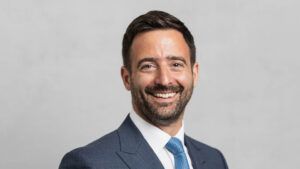ESG Clarity is exploring the decarbonisation targets set by Net Zero Asset Managers’ initiative (NZAM) firms as well as talking to individual fund groups about how they are finding the journey to net zero.
See also: – ESG Clarity’s Net Zero Database
Here Neil Brown, head of equities at GIB Asset Management, explains the fund house’s progress on its emissions targets, and why keeping exposure to net–zero solution providers can mean exposure to companies that are higher emitters.
Can you tell us how your journey to net zero started and how it’s going now?
We are in launch mode at GIB AM having brought together a range of sustainable investors over the past few years to launch our Sustainable World fund in 2021, our Emerging Markets Active Engagement fund and Sustainable World Corporate Bond fund in 2022, and our European Focus Fund in 2023. As we built out our active business we became a founding member of NZAM to help drive on this important initiative that fits with our core beliefs.
Ddecarbonisation should be comprehensive across all sectors of the economy and investors who seize the opportunities in solving this challenge can outperform. Our Sustainable World fund looks for companies that can impact our themes that are focused on people and planet and within planet we have clean energy and efficiency. Focusing in on those companies that can impact these themes we assess company behaviours such as performance on the principal adverse indicators which include emissions and carbon reduction plans.
How are you engaging firms on absolute emissions reduction?
We prioritise the achievement of real-economy emissions reductions within the sectors and companies in which we invest. Therefore we focus our engagements on companies with a larger emissions profile in our portfolios. Our engagements include speaking to management about their carbon reduction plans and encouraging them to have short-, medium- and long-term targets to allow for tracking of progress.
We treat emissions reduction targets as a “north star” and focus our engagement efforts into how the management are implementing absolute emissions reductions across their business. As discussed in our collaborative paper with CDP, in the race to net zero, we need every company over the finish line.
You have engagement goals as a ‘portfolio coverage’ target, how does that work?
The portfolio coverage approach is a bottom-up approach that is consistent with our investment approach. Focusing on getting companies themselves onto a decarbonisation pathway that achieves real-world reductions. Our target is to have 80% of in-scope assets to be ‘committed to aligning’, ‘aligning with net zero’, ‘aligned with net zero’, or ‘achieving net zero’, by 2025; 90% by 2030; and 100% by 2035, including >50% fully aligned by 2035, as defined by the Paris Aligned Investment Initiative methodology.
You have chosen ‘issuers themselves setting targets’ as one measure – how does that work and how is it going?
It is clear that companies are key to reaching net zero, and firms should understand the importance of net-zero targets, and increasing resiliency, to their stakeholders. We are keen to see science-based accredited targets within our Sustainable World fund, therefore have reached out to our holdings that did not meet this and worked with them on explaining the merits of having targets that are impactful, measurable and transparent.
How do you factor in Scope 3 to your investment and engagement activities?
We recognise the difficulties for companies in working through Scope 3, but there is merit in their disclosure by companies and analysis by investors. In our recently released impact report we include Scope 3 emissions as we understand that these emissions can represent the largest source of emissions for companies.
These emissions require measurement outside of a company’s organisational boundaries, meaning that they are significantly harder to calculate. Reporting is, of course, far less comprehensive for Scope 3 emissions than it is for Scope 1 and 2 emissions but we believe they need to become a part of consistent and transparent reporting.
What has been the biggest challenge in decarbonising your portfolio?
For our thematically driven Sustainable World fund, which assesses company revenue exposure and behaviours on emissions, we are already significantly below benchmark emissions. This makes further decarbonisation harder but nonetheless important for all companies. We want to keep exposure to net-zero solution providers and that can mean exposure to companies that are higher emitters even though this is much less than the emissions their products save in the real world.
More broadly at GIB AM, some sectors and regions will be able to go faster than others with the rate of change being impacted by government and policy interventions. This is particularly important where we manage index portfolios for our clients, where (aside from engagement), there is limited scope for us as a manager to drive emissions reductions – and hence we currently have kept passive mandates out of the scope of our net-zero commitments. We need alignment across all stakeholders to allow the companies of today to make profitable plans that can deliver a just and lasting transition to net zero.
| When did you sign up to the NZAMI? | December 2020 |
| AUM committed to net zero ($) | Approx. $250m |
| % AUM committed to net zero | 2.46% (We have a low percentage of in-scope assets because all passively managed assets are currently assessed as out of scope.) |
